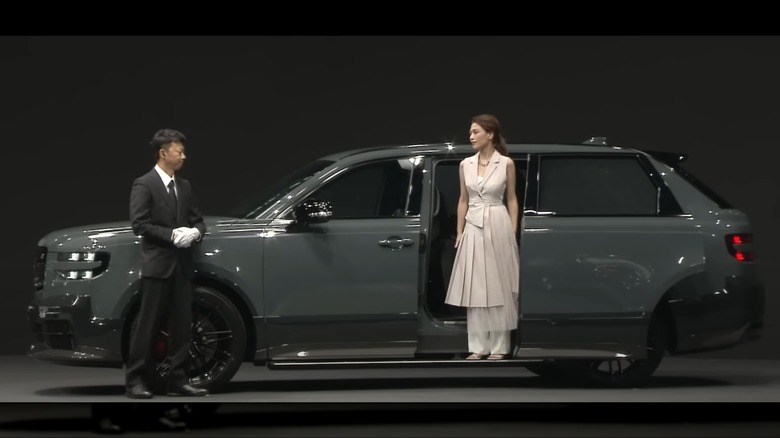A New Toyota Model May Be The Only SUV With Sliding Doors
Toyota quietly slipped something pretty unique into its luxury lineup: the new Century SUV, which, depending on the spec, includes sliding rear doors. Not coach doors. Not wide-swing hinges. Actual sliding doors. The kind usually reserved for minivans and commercial vans. This makes the Century SUV a bit of an outlier in a market where SUVs have overwhelmingly stuck with traditional doors, even on ultra-luxury models.
Sliding doors make a lot of sense in tight urban spaces, which is likely why Toyota introduced them as an option for the Japan-only GR-badged version of the Century SUV — which makes it hard to understand why it isn't sold in the US. The GR variant retains the finely finished exterior but swaps the standard swing doors for power-operated sliding ones, giving rear-seat passengers limousine-level ease of entry.
There's some debate as to whether these can even be considered sliding doors, as they employ a rear-mounted hinge instead of rails to open. Regardless, they fulfill the basic function of a sliding door and are suited for cramped spaces.
Is it still an SUV? Yes. The Century sits on the TNGA-K platform, shared with the Highlander, Sienna, and Camry. It's taller than the sedan it replaces, and is styled to look more Cullinan than Carnival. But that sliding door changes the experience. It shifts the vehicle from driver-focused to rider-first, especially with its rear lay-flat seats, laminated glass divider, and plug-in hybrid drivetrain.
No other mainstream SUV, luxury or otherwise, currently ships with sliding rear doors. That makes the Century GR SUV something rare. An SUV that borrows the most functional feature from a segment consumers keep ignoring.
Why sliding doors work better than swinging ones in SUVs
Sliding doors aren't new. The first vehicle to use them was the Citroën TUB, a delivery van from the 1930s. Since then, vans and minivans have used them for one simple reason: they work better in tight spaces. And they're safer. You're less likely to ding a neighboring car or get a door caught by the wind.
So why don't more SUVs use them? Simple: image. Sliding doors have been tied to minivans, and minivans have been tied to parenting and practicality — which are not exactly aspirational traits in a market dominated by rugged looks and luxury pretensions.
The Toyota Century SUV shows what's possible when an automaker lets form follow function. The sliding doors make it easier for passengers to enter and exit without compromising the styling. Add in four-wheel steering and a chauffeur-focused ride mode, and you've got one of the most luxurious SUVs that unfortunately hasn't been made available in America yet.
Could this change how SUVs are designed?
Toyota's move to add sliding doors to a luxury SUV isn't just a quirky design choice. It might mark the start of a shift. For years, buyers have wanted minivan function without the minivan label. SUVs offered the style and presence, but lost out on ease of use. The Century SUV finds a middle ground.
Other brands are already pushing the line. Kia's Carnival is technically a minivan, but from the 2020 model onwards, it's designed to look like a rugged crossover. Toyota's Sienna has borrowed SUV styling cues for years. But the Century goes the other direction, starting from a luxury SUV platform and incorporating features typically avoided in the segment.
This could open the door (literally) to a new design direction. If buyers respond positively, luxury brands like Lexus or even Mercedes could follow. SUVs might start adopting features long dismissed as "minivan-only," if it means better functionality.
The Toyota Century SUV won't be sold globally, yet. But it might be the start of something bigger. If sliding doors can work on a $170,000 SUV, who's to say they won't show up on more mainstream ones next? Speaking of bucking trends, here are some of the weirdest SUVs that dared to break the mold.


